Who Are The Corded Ware People (Updated)
Today we will discuss the Corded Ware Culture and the people associated with it culturally .
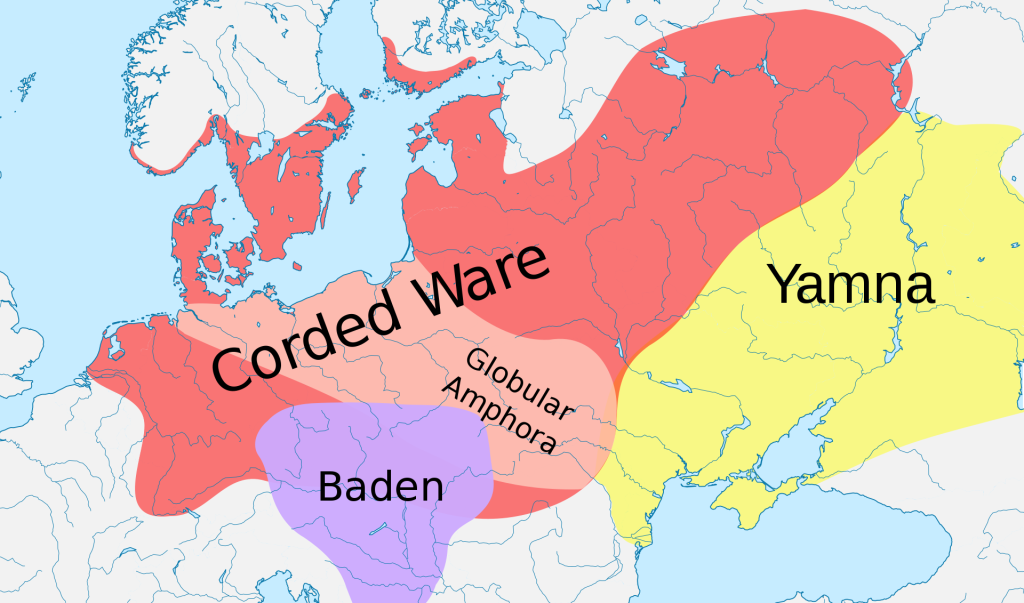
The Corded Ware culture is the western expression of the ancient Yamna or Yamnaya Culture of the Pontic/Caspian Steppes and possibly has components of West Central European Neolithic elements (David Anthony). Sintashta are the eastern expression of the Corded Ware and may represent what we today call Schythians, a mysterious Indo European tribe who seem to absorb or represent more than one later group. Genetically we see them connected with Gothic peoples, Slavs, Celts and some Uralic speakers as their empire stretched well across Eurasia. The Yamnaya people or maybe more accurately Proto Indo Europeans, theoretically appear to be the admixture of Caucasus Hunter Gatherers and Eastern Hunter Gatherers. R1B-R1A and G2A YDNA. The Neolithic farming communities of the Balkans and eventually all of Europe were descended from these Caucasus Hunter Gatherers as well (G2A). They had spread from the Caucasus into Anatolia and then to Europe. The Western Hunter Gatherer’s haplogroup ancestor (IJK) more than likely originated in the Caucasus or Iran. The I group then within Europe separated from IJK. R1B existed in Mesolithic Europe but rarely and did not see great expansion until the Corded Ware and Bell Beaker Complex. One of the Ancestral components of the Eastern Hunter Gatherer is the “Ancient North Eurasian” who is a common ancestor of Indo Europeans via the EHG and Siberian, Native American peoples via those who migrated to the Americas from East of the Urals. The Haplogroups U and H in MTDNA phylogenetic tree are children of the parent haplogroup MTDNA R. These represent a great deal of female European ancestry along with K, T and many others. The G haplogroup is technically a lesser branch of IJK from which the I, J and K YDNA groups are derived.
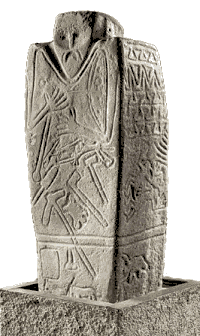




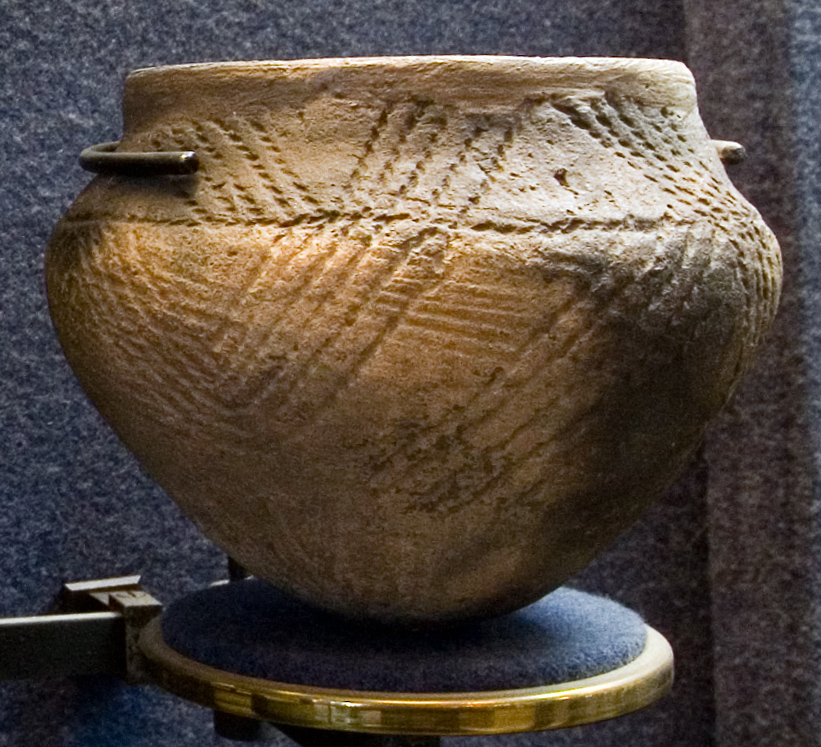
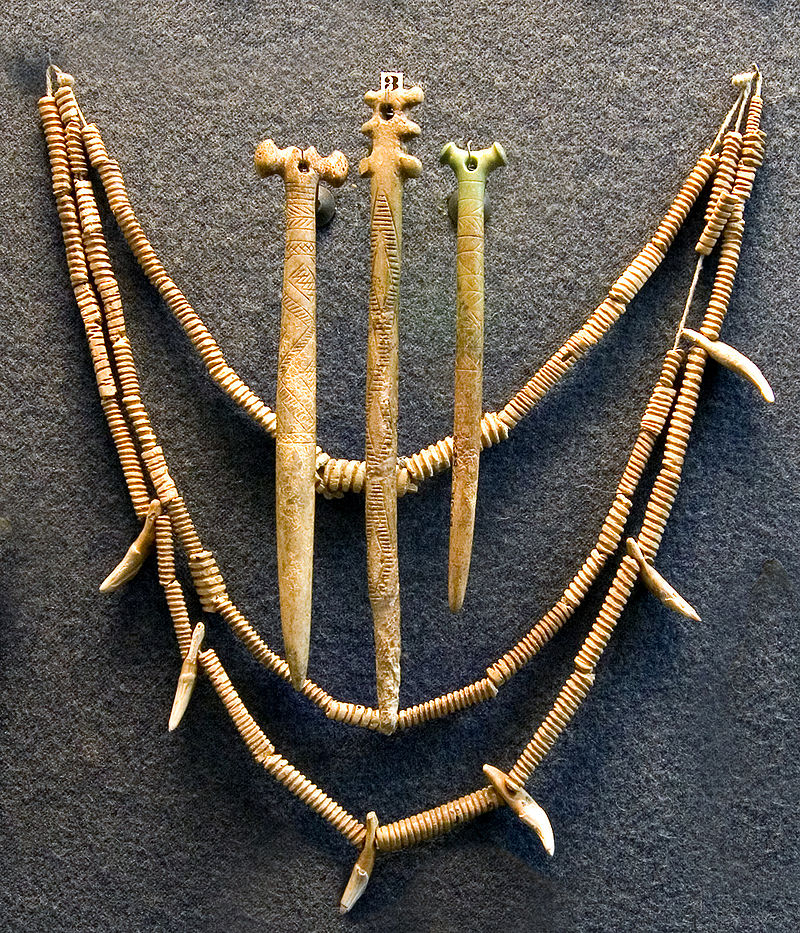


(Above) Yamnaya Culture related materials.
I DO NOT OWN THESE IMAGES , NORE DO I CLAIM ANY CREDIT TO THEIR CREATION. COPYRIGHT TO THE ORIGINAL CREATOR. MOST WERE TAKEN FROM WIKIPEDIA OR GOOGLE IMAGES.

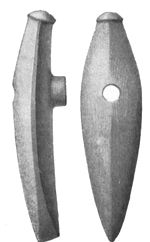






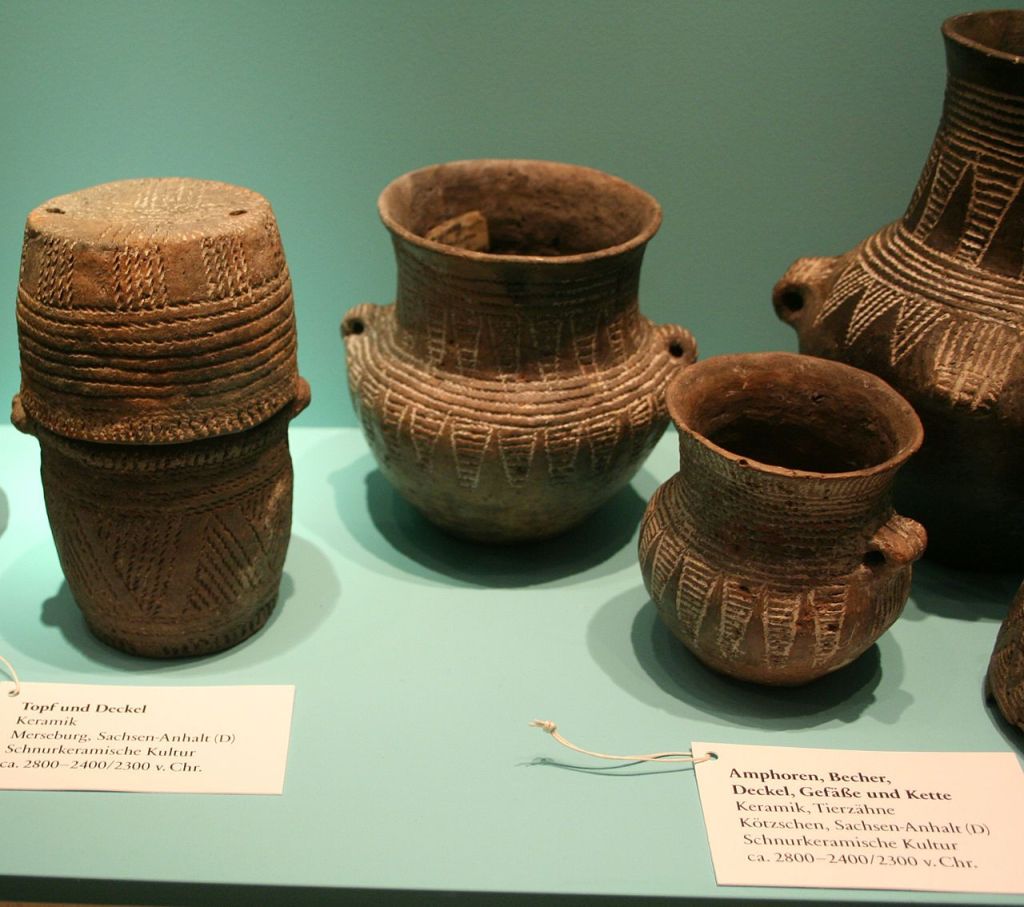
(Above) Corded Ware associated artifacts.
I DO NOT OWN THESE IMAGES , NORE DO I CLAIM ANY CREDIT TO THEIR CREATION. COPYRIGHT TO THE ORIGINAL CREATOR. MOST WERE TAKEN FROM WIKIPEDIA OR GOOGLE IMAGES.
The move from the Steppes to Central, Western and Northern Europe:

I DO NOT OWN THIS IMAGE: Source Google Search.
The people of Eurasia were largely Hunter Gatherers up till the Neolithic when groups in the Caucasus, Balkans and Anatolia began to develop and spread new farming technologies northward into Central Europe. In certain areas hunter forager cultures persisted such as in
Scandinavia and parts of the Urals and Western Steppe. Eventually Europe was overtaken by the new technologies and hunting centered life decreased but remained at least in some form as a guarantee against bad yields. The Farming groups represented by Varna, Vinca , LBK and others brought the Megalithic structures to western Europe and Scandinavia. It should be noted that signs of indigenous farming may have been detected before the arrival of Caucasian groups. These farming groups are believed to have been the evolution of the Caucasus Hunter Gatherer (CHG) a distinct group who’s G2A Haplogroup was the primary YDNA of the farming expansion while H in various forms and others were the MTDNA. The H groups also may have had some European distribution in the Mesolithic as well. The Northern contemporaries of the CHG were the Eastern Hunter Gatherer (EHG) centered in modern Russia, The Urals, Scandinavia and Finland. These Hunters were partly descended from the “North Asian Hunter Gatherer” and are the ancestral originators of the R YDNA group (R, R1B,R1A). It is suggested among other theories that the remaining CHG and EHG combined into a new culture and genetic group ancestral to the Yamnaya culture centered in Pontic Caspian steppes north of the Black Sea and Caucasus. This new culture with a complicated language began expanding in the late Neolithic north, South, East and West. The new culture was marked by changes in ideology, travel and customs demarcating them as different or novel from the previous farming and hunting cultures and separated from them by many generations. In a large picture they are the descendant in part from Farming groups but many generations removed. The language spoken was likely Proto Indo-European, a grammatically complicated heavily declined language resistant to barrowing from other languages. This language carried cultural terms unique to it revolving around horse domestication, wheels and mobile economy. It is theorized that this group was the first to tame and ride horses (Horse, Wheel and Language , David Anthony) and create a mobile semi nomadic wheel based economy. The oldest wheel to date on Earth was found in Slovenia at 5350 years old. This would place the wheel in the heartland of Neolithic European farming culture and at the edge of Expanding Steppe Cultures (PIE/WSH). It is also suggested (Theorized) that the Chariot was invented in the Steppes by PIE cultures and spread south via the Caucasus to the Middle and Near East. Archeology and linguistics supports this (David Anthony ). The remnants of words relating to these things are found throughout many ancient branches of PIE. The exact age of the branching is unknown, In David Anthony’s book he points out that Germanic/Baltic/Slavic might be the oldest branching after Anatolian and Tocharian . Also pointed out in David Anthony’s book the PIE language share deep relationships with Uralic language groups via very archaic shared pronouns and other features. In his book he relates the possibility of a shared Ancestor that by PIE and Uralic families descended from. Given the geography I think this is an interesting idea but these are now distinct language families and may have been related in only the most ancient sense. I would like to Add that the Basque language is sometimes referred to as a candidate for the only surviving Neolithic Language with no known membership in existing language families, however recent studies have found similarities with modern Caucasus based languages and the Basque share a similarity with Neolithic populations in a similar way as Sardinians. These Neolithic peoples were originally from the Caucasus and carried the Caucasian G2A Haplogroup that is prevalent still in the Caucasus and Mediterranean populations.
NOTE:
When I speak of interrelatedness to these ancient cultures it is through a modern lens and in no way reflects their actual interactions or relationships nor implies they saw themselves as related to each other.
Why the Expansion took place and what spurred it is unknown but archeology tells us that signs of steppe influence began to be detected in Late Neolithic cultures at the fringe steppe areas, Carpathian Basin, Danube Valley and other places. This included technology, status symbols and burial customs. Signs of hostile force is also detected where WSH groups replace or run out previous Neolithic cultures as they move west into Europe. Signs of peaceful coexistence also exist. The Western and Scandinavian hunters appear to have been most durable to this and you see the Hunter YDNA (I,I2,I1) persist in Scandinavia and have resurgence during the post Bell Beaker Central European Bronze Age. This however was not the case in Britain as the PIE DNA both Autosomaly and YDNA replaces the previous population within several generations. Britain is heavily WSH derived while Scandinavia retains as high as 60% Hunter derived YDNA (I1A) but via autosomal is heavily WSH derived. After 3000BC The Corded ware and their descendants start to become the majority culture in Northern Europe. The story in Southern Europe Is markedly different in that the culture existing when WSH people arrived were much more diverse.
It is believed the Corded Ware culture might have been the group responsible for introducing PIE languages to Northern Europe and other ascribe it as specifically Ancestral to Germanic culture however the Corded Ware horizon appears to be Ancestral all Northern European cultures including Germanic, Celtic, Slavic and Baltic etc. *My view is that the interaction with unique indigenous groups played at least some role in post CWC groups evolving into unique cultures we see today:
WEST CENTRAL EUROPE: Mesolithic to Later Iron Age.
+> indicates shared origin.
* indicates an adjacent culture and genetic contact with PIE groups.
These charts are not exhaustive to every culture or group.
Western Hunter Gatherer*
Neolithic Farmer*
CWC Horizon+>
Bell Beaker Trade Complex+>
Unetice+>
Tumulus+>
Urnfield culture+>
Hallstatt Bronze Age/Iron Age+>
Le Tene Culture (Iron Age)+>
Pan Celtic civilization +>.
NORTHERN EUROPE: (Mesolithic to Iron Age)
Western, Eastern and Scandinavian Hunters *
Neolithic Farmers*
Funnelbeaker Culture (Hunter/Farmer mixed) *
CWC+>
Single Grave Culture+>
Beaker Culture+>
Unetice Culture+>
Nordic Bronze Age+> (Recognizable signs of Germanic Culture)
Jastorf and Wielbark Cultures (Iron Age)+>
Pan Germanic Cultures+>
BRITAIN: Mesolithic to Iron Age..
Hunter Gatherer (First Population) *
Neolithic Farmer (Second population) *
Bell Beaker Chalcolithic Warrior (Pie)+>
Bronze Age Briton (Descended from Beaker)+>
Le Tene Celtic culture+> (Arrives from NW Europe Iron Age)
British Celtic Tribes+>
EASTERN EUROPE:
Eastern Hunter and North Eurasian Hunter+> (Ancestor to Sredny-Stog-Yemnaya)
Western Hunters+>*
Caucasus Hunter+>*
Neolithic Farmers+> CHG* (Simplified term for many cultures)
Contemporary Forager Cultures *
Sredny Stog (Pre PIE? EHG-CHG) +>
Yamnaya (Pie) +> (EHG and CHG)
Corded Ware-Fatyanovo, Sintashta, Andronovo, Srubnaya Etc.+>
Únětice culture+>
Lusation Urnfield Culture +>
Schythians and Aryans (Non political meaning)+>
Pre Slavs?+>
This is just to give a bare idea of the influence of Steppe culture throughout Europe.
Tumulus and Urnfield cultures are mentioned as possibly Ancestral to Celtic culture which was later expressed by the Hallstatt Culture. Often Germanic and Celtic are placed close in the PIE family tree but recent opinions have linked Italic and Celtic as a western branch and Germanic, Baltic and Slavic as a Northern Branch. This being said it is not hard to see a general relatedness especially in the ancient form of each of these languages. Their exact correct placement is unknown as is their exact date of branching. Germanic may have branched as far back as 3500BC or as recently as the Nordic Bronze Age. Germanic customs have a certain amount of unique traits that may be remaining elements of the Pitted Ware Culture or other Scandinavian Hunting groups. As mentioned above Germanic populations are generally higher in Hunter and then Steppe ancestry while southern Europe is more farmer derived. Central Europe being the epicenter of WSH culture (PIE) has high relations rates to Yamnaya derived groups with less hunter and farmer. South Eastern Europe also has distribution WHG I2A. Neolithic female populations play a greater role in Northern Europe than male lineages as G2A is rare but I-M170 with its descendants and R1B/R1A are frequent. Germanic culture appears at least with current information to have been born out of the Hunter/Corded Ware and Single Grave/Bell Beaker group in Jutland or Southern Sweden. It then developed into the Nordic Bronze Age with at least some influence from Unetice and Hallstatt via trade and other contact. All of this of course is hypothetical postulating.
A further note:
In the ideas above I have simplified many elements and the info is not exhaustive. I also want to make sure that the Neolithic cultures are not under represented. The Funnelbeaker Neolithic culture was very widespread in Scandinavia and butted up to remaining Scandinavian hunters like the Pitted Ware culture. This same culture (Funnelbeaker) was also in Germany, Poland and Czechia when the Late Yamnaya arrived from Eastern Europe/Western Steppes. David Anthony proposes they arrived through the Danube Valley and that Corded Ware was a local construction that the Yamnaya made contact with and this grew into the wide spread Corded Ware culture that may have brought PIE languages to Northern Europe. They may have also carried not just PIE elements but remaining Neolithic elements as well. He also proposes the Beaker folk was a pre existing culture that Corded Ware made contact with but we know now via DNA that the Beaker Culture was descended from the same source population as Corded Ware and Yamnaya. In the Same section of his book it is put forth that the Ancestor of Germanic bifurcated from PIE in Eastern Europe which may be true but the actual language we know as Germanic I personally believe developed in Scandinavia nor central Europe during the Corded Ware/Single Grave period . On the subject of Bell Beaker I want to touch on my previous articles and after gaining further insight from the second time I read The Horse, Wheel and Language. The Bell Beaker designs appear to be either evolution from Corded Ware or Funnelbeaker/Corded/Protruding Foot Beaker designs or cruder copies of a Neolithic Iberian design. The Atlantic EBA was flourishing at this point and these could have been traded north from existing Neolithic crafters into arisen Yamnaya descended areas. We know via DNA the Beaker folk were not local to Western Europe but part of migratory Steppe peoples who likely Spoke PIE languages. It could be seen in a way that the Bell Beaker people (not pottery) were just the western most expression of Corded ware that picked up a new pottery style. Other Proto Indo Europeans groups earlier in development sometimes used pottery from surrounding areas. Sintashta and other CWC derived groups became unique eastern branches of CWC so why not a western most branch? The basic traditions of Corded Ware/Battle Axe/ Single Grave were intact in the Bell Beaker horizon. These traditions included single grave burials with goods like stone axes or hammers, copper daggers and Kurgans erected above the grave. The Beaker People represent the majority of British ancestors but are we to believe CWC just stopped at the coast and Beaker people had no connection?. We now have DNA to answer the question that yes The Beaker Folk were Corded Ware and that R1B was prevalent in CWC peoples. Some make them ancestral to Germanic, some to Celtic and Italic cultures. I would also like to add that I agree with the theory that Germanic, Baltic and Slavic belong in a branch together and Celtic and Italic belong in another branch around the Alps perhaps. If you look at word forms and etymology Celtic and Italic languages share some traits as well and mythology elements. If you look at certain words and mythology between Germanic, Baltic and Slavic languages certain elements are shared such as a female personification of the Sun, symbols, cosmology and animistic nature worship elements. A great deal of shared elements can be seen across Indo European religion and Germanic and Celtic people had considerable contact with each other but so did Germanic, Baltic and Slavic peoples. The contribution of the stone axe in the Corded Ware/Battle Axe cultures may have been pre-existing among the Funnelbeaker and other Indigenous groups. The Neolithic cultures of Europe, although likely distributed via Female lineages should not be underestimated either. It is recorded that males in the LBK culture of Central Europe’s Neolithic were buried with Stone axes. These males made little impact genetically but their women and traditions may have.
I hope this inspired you to dive into European Anthropology. Please go read and make up your own mind. I am only an amateur but find it endlessly fascinating.
Books and resources:
The Horse, The Wheel and Language by David Anthony (Highly detailed)
Skelhøj by Madz Kähler and Marrianne Rasmussen (Very Technical)
Bronze Age Metal Work by Nørgaard (Very Technical)
The Mound People by Glob
The Bog People By Glob
Myths and symbols in Pagan Europe by H.R Ellis Davidson (Early Celt and Germanic religion)
Eupedia.com (Great Maps and info on DNA)
Wikipedia.com (with a grain of salt/check other sources)
Wiktionary.com (etymology and tables)
Youtube.com (Good Documentaries)
Happy researching!!
Hroð-

Leave a comment